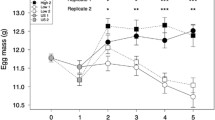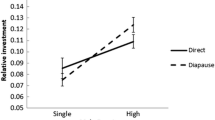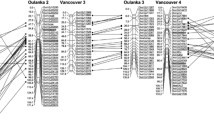Abstract
Genetic correlations between male and female traits can act as evolutionary constraints and, if involving reproductive traits, potentially influence sexual selection. Artificial selection on egg size in the tropical butterfly Bicyclus anynana has yielded highly divergent lines. Here we report evidence for correlated evolution in male traits. Males from the large-egg selected lines produced significantly heavier spermatophores independent of body size and tended to have more fertile sperm stored in their reproductive tracts than those from the small-egg selected lines. This may be due to an underlying genetic correlation in reproductive effort between the sexes. However, non-fertile sperm number and testis size remained unaffected by selection on egg size. Phenotypic correlations within an unselected population revealed that spermatophore mass and fertile sperm number, but not testis size and non-fertile sperm number, were positively related to male body size, and that larger spermatophores contained more fertile, but not non-fertile sperm. In addition, males provided larger females with bigger spermatophores and more fertile sperm, indicating males may be exercising mate choice during copulation.


Similar content being viewed by others
References
Azevedo RBR, French V, Partridge L (1997) Life-history consequences of egg size in Drosophila melanogaster. Am Nat 150:250–282
Bissoondath CJ, Wiklund C (1996) Effect of male mating history and body size on ejaculate mass and quality in two polyandrous butterflies, Pieris napi and Pieris rapae (Lepidoptera: Pieridae). Funct Ecol 10:457–464
Boggs CL (1990) A general model of the role of male-donated nutrients in female insects’ reproduction. Am Nat 136:598–617
Brakefield PM, Reitsma N (1991) Phenotypic plasticity, seasonal climate and the population biology of Bicyclus butterflies (Satyridae) in Malawi. Ecol Entomol 16:291–303
Brakefield PM, El Filali E, Van der Laan R, Breuker CJ, Saccheri IJ, Zwaan BJ (2001) Effective population size, reproductive success and sperm precedence in the butterfly, Bicyclus anynana, in captivity. J Evol Biol 14:148–156
Chapman T (2001) Seminal fluid-mediated fitness traits in Drosophila. Heredity 87:511–521
Cook PA, Gage MJG (1995) Effects of risks of sperm competition on the numbers of eupyrene and apyrene sperm ejaculated by the moth Plodia interpunctella (Lepidoptera: Pyralidae). Behav Ecol Sociobiol 36:261–268
Cook PA, Wedell N (1996) Ejaculate dynamics in butterflies: a strategy for maximizing fertilization success? Proc R Soc Lond B 263:1047–1051
Cook PA, Wedell N (1999) Non-fertile sperm delay female remating. Nature 397:486
Czesak ME, Fox CW (2003) Evolutionary ecology of egg size and number in a seed beetle: genetic trade-off differs between environments. Evolution 57:1121–1132
Engqvist L, Sauer KP (2003) Determinants of sperm transfer in the scorpionfly Panorpa cognate: male variation, female condition and copulation duration. J Evol Biol 16:1196–1204
Ferkau C, Fischer K (2006) Costs of reproduction in male Bicyclus anynana and Pieris napi butterflies: effects of mating history and food limitation. Ethology 112:1117–1127
Fischer K, Bot ANM, Brakefield PM, Zwaan BJ (2006a) Do mothers producing large offspring have to sacrifice fecundity? J Evol Biol 19:380–391
Fischer K, Bauerfeind SS, Fiedler K (2006b) Temperature-mediated plasticity in egg and body size in egg size-selected lines of a butterfly. J Therm Biol 31:347–354
Fox CW, Czesak ME (2000) Evolutionary ecology of progeny size in arthropods. Annu Rev Entomol 45:341–369
Friedländer M, Seth RK, Reynolds SE (2005) Eupyrene and apyrene sperm: dichotomous spermatogenesis in Lepidoptera. Adv Insect Physiol 32:206–308
Gage MJG (1998) Influences of sex, size and symmetry on ejaculate expenditure in a moth. Behav Ecol 9:592–597
Gage AR, Barnard CJ (1996) Male crickets increase sperm number in relation to competition and female size. Behav Ecol Sociobiol 38:349–353
Gage MJG, Cook PA (1994) Sperm size or numbers? Effects of nutritional stress upon eupyrene and apyrene sperm production strategies in the moth Plodia interpunctella (Lepidoptera: Pyralidae). Funct Ecol 8:594–599
Giebultowicz JM, Riemann JG, Raina AK, Ridgway RL (1989) Circadian system controlling release of sperm in the insect testes. Science 245:1098–1100
Gillott C (2003) Male accessory gland secretions: modulators of female reproductive physiology and behavior. Annu Rev Entomol 48:163–184
Gurdon GB (1991) Nuclear transplantation in Xenopus. In: Kray B, Peng B (eds) Methods in cell biology, vol 36. Academic Press, London, pp 299–306
Gwynne DT (1984) Sexual selection and sexual differences in Mormon crickets (Orthoptera, Tettigoniidae, Anabrus simplex). Evolution 38:1011–1022
Honek A (1993) Intraspecific variation in body size and fecundity in insects: a general relationship. Oikos 66:483–492
Hosken DJ, Ward PI (2001) Experimental evidence for testis size evolution via sperm competition. Ecol Lett 4:10–13
Hosken DJ, Garner TWJ, Ward PI (2001) Sexual conflict selects for male and female reproductive characters. Curr Biol 11:489–493
Houle G (2001) Reproductive costs are associated with both the male and female functions in Alnus viridis ssp. crispa. EcoScience 8:220–229
Jenkins SH (2002) Data pooling and type I errors: a comment on Leger & Didrichsons. Anim Behav 63:F9–F11
Jensen H, Saether BE, Ringsby TH, Tufto J, Griffith SC, Ellegren H (2003) Sexual variation in heritability and genetic correlations of morphological traits in house sparrow (Passer domesticus). J Evol Biol 16:1296–1307
Karlsson B (1998) Nuptial gifts, resource budgets, and reproductive output in a polyandrous butterfly. Ecology 79:2931–2940
LaMunyon GW (2000) Sperm storage by females of the polyandrous noctuid moth Heliothis virescens. Anim Behav 59:395–402
LaMunyon GW, Huffmann S (2001) Determinants of sperm transfer by males of the noctuid moth Heliothis virescens. J Insect Behav 14:187–199
Lande R (1980) Sexual dimorphism, sexual selection, and adaptation in polygenic characters. Evolution 34:292–305
Larsen TB (1991) The butterflies of Kenya and their natural history. University Press, Oxford
Lewis Z, Wedell N (2007) Effects of adult feeding on male mating behaviour in the butterfly, Bicyclus anynana (Lepidoptera: Nymphalidae). J Insect Behav 20:201–213
Lynch M, Walsh B (1998) Genetics and analysis of quantitative traits. Sinauer, Sunderland
Marshall LD (1982) Male nutrient investment in the Lepidoptera: what nutrients should males invest? Am Nat 120:273–279
Miller GT, Pitnick S (2002) Sperm-female coevolution in Drosophila. Science 298:1230–1233
Mölleman F, Zwaan BJ, Brakefield PM (2004) The effect of male sodium diet and mating history in the puddling squinting bush brown Bicyclus anynana (Lepidoptera). Behav Ecol Sociobiol 56:404–411
Moore PJ, Harris WE, Montrose VT, Levin D, Moore AJ (2004) Constraints on evolution and postcopulatory sexual selection: trade-offs among ejaculate characteristics. Evolution 58:1773–1780
Oberhauser KS (1988) Male monarch butterfly spermatophore mass and mating strategies. Anim Behav 36:1384–1388
Oberhauser KS (1992) Rate of ejaculate breakdown and intermating intervals in monarch butterflies. Behav Ecol Sociobiol 31:367–373
Park YI, Ramaswamy SB, Srinivasan A (1998) Spermatophore formation and regulation of egg maturation and oviposition in female Heliothis virescens. J Insect Physiol 44:903–908
Parker GA (1970) Sperm competition and its evolutionary consequences in insects. Biol Rev 45:525–567
Parker TH, Garant D (2005) Quantitative genetics of ontogeny of sexual size dimorphism in red junglefowl (Gallus gallus). Heredity 95:401–407
Rice WR, Chippindale AK (2001) Intersexual ontogenetic conflict. J Evol Biol 14:685–693
Roff DA (1996) The evolution of genetic correlations: an analysis of patterns. Evolution 50:1392–1403
Roff DA (1997) Evolutionary quantitative genetics. Chapman & Hall, New York
Silberglied RE, Shepherd JG, Dickinson JL (1984) Eunuchs: the role of apyrene sperm in Lepidoptera. Am Nat 123:255–265
Simmons LW (2001) Sperm competition and its evolutionary consequences in the insects. University Press, Princeton
Simmons LW (2003) The evolution of polyandry: patterns of genotypic variation in female mating frequency, male fertilization success and a test of the sexy-sperm hypothesis. J Evol Biol 16:624–634
Simmons LW, Parker GA (1989) Nuptial feeding in insects––mating effort versus paternal investment. Ethology 81:332–343
Stearns SC (1992) The evolution of life histories. University Press, Oxford
Svärd L, Wiklund C (1989) Mass and production rate of ejaculates in relation to monandry/polyandry in butterflies. Behav Ecol Sociobiol 24:395–402
Underwood AJ (1997) Experimental ecology: their logical design and interpretation using analyses of variance. University Press, Cambridge
Vahed K (1998) The function of nuptial feeding in insects––review of empirical studies. Biol Rev 73:43–78
Van’t Hof AE, Zwaan BJ, Saccheri IJ, Daly D, Bot ANM, Brakefield PM (2005) Characterization of 28 microsatellite loci for the butterfly Bicyclus anynana. Mol Ecol Notes 5:169–172
Virkki N (1969) Sperm bundles and phylogenesis. Z Zellforsch 101:13–27
Wedell N (1996) Mate quality affects reproductive effort in a paternally investing species. Am Nat 148:1075–1088
Wedell N (1997) Ejaculate size in bushcrickets: the importance of being large. J Evol Biol 10:315–325
Wedell N (2005a) Female receptivity in butterflies and moths. J Exp Biol 208:3433–3440
Wedell N (2005b) Sperm competition in butterflies and moths. In: Fellows MDE, Holloway GJ, Rolff J (eds) Insect evolutionary ecology. Cabi Publishing, Wallingford, pp 49–81
Wedell N (2006) Male genotype affects female fitness in a paternally investing species. Evolution 60:1638–1645
Wedell N, Cook PA (1998) Determinants of paternity in a butterfly. Proc R Soc Lond B 265:625–630
Wedell N, Cook PA (1999a) Strategic sperm allocation in the small white butterfly Pieris rapae (Lepidoptera: Pieridae). Funct Ecol 13:85–93
Wedell N, Cook PA (1999b) Butterflies tailor their ejaculate in response to sperm competition risk and intensity. Proc R Soc Lond B 266:1033–1039
Wedell N, Karlsson B (2003) Paternal investment directly affects female reproductive effort in an insect. Proc R Soc Lond B 270:2065–2071
Wedell N, Gage MJG, Parker GA (2002) Sperm competition, male prudence and sperm-limited females. Trends Ecol Evol 17:313–320
Wiklund C, Kaitala A (1995) Sexual selection for large male size in a polyandrous butterfly: the effect of body size on male versus female reproductive success in Pieris napi. Behav Ecol 6:6–13
Wiklund C, Karlsson B (1988) Sexual size dimorphism in relation to fecundity in some Swedish satyrid butterflies. Am Nat 131:132–138
Wolfner MF (2002) The gifts that keep on giving: physiological functions and evolutionary dynamics of male seminal proteins in Drosophila. Heredity 88:85–93
Acknowledgements
We thank David Hosken and John Hunt for discussions and David Hosken for valuable comments on the manuscript. Financial support was provided by the German Research Council (DFG grant no. Fi 846/1-2 and 1-3) to KF, and the Royal Society, the Leverhulme Trust and the European Social Fund to Nina Wedell.
Author information
Authors and Affiliations
Corresponding author
Rights and permissions
About this article
Cite this article
Fischer, K., Zimmer, K. & Wedell, N. Correlated responses to selection on female egg size in male reproductive traits in a butterfly. Evol Ecol 23, 389–402 (2009). https://doi.org/10.1007/s10682-007-9233-1
Received:
Accepted:
Published:
Issue Date:
DOI: https://doi.org/10.1007/s10682-007-9233-1




